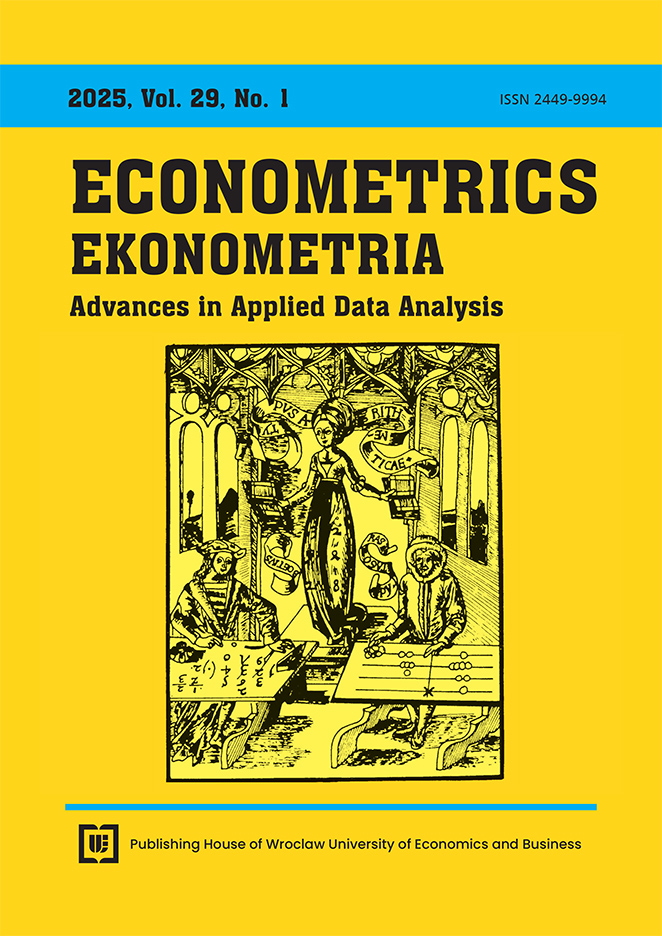Reduction of Climate Risk as a Key to Business Performance – Framework for Sustainable Corporate Treasury Management (CTM)
DOI:
https://doi.org/10.15611/eada.2025.1.02Keywords:
climate risk, sustainable treasury management, effectiveness of the entity, Corporate Treasury Management (CTM)Abstract
Aim: The article aims to examine the impact of climate instability risk on Corporate Treasury Manage-ment (CTM) and demonstrate that sustainable strategies can effectively mitigate this risk while enhancing corporate financial performance.
Methodology: A theoretical and empirical approach is employed, including econometric modelling, case study analysis, and literature review, with a focus on the use of financial instruments – particularly climate derivatives – within CTM.
Results: Effective management of climate risk through sustainable policies and financial instruments raises treasury levels and strengthens corporate competitiveness by reducing unexpected losses and the costs of maintaining high liquidity reserves.
Implications and recommendations: The study recommends incorporating environmentally conscious strategies into CTM and implementing fiscal incentives and regulatory frameworks to support climate risk hedging tools. Further research should explore sector-specific applications of sustainable CTM, especially in climate-sensitive industries.
Originality/value: The article offers a novel integration of sustainability and treasury optimisation, showing that environmental responsibility can directly support and enhance core financial goals within CTM frameworks.Downloads
References
Arian, A., & Naeem, M․ A․ (2025)․ Climate Risk and Corporate Investment Behavior in Emerging Economies․ Emerging Markets Review, 65, 101257․ https://doi.org/10.1016/j.ememar.2025.101257
Arrow, K․ (1969)․ Essays in the Theory of Risk-Bearing․ Markham.
Bagh, T., Jiang, F., & Khan, M. A. (2024). From Risk to Resilience: Climate Change Risk, ESG Investments Engagement and Firm’s Value. Heliyon, 10(5), e26757. https://doi.org/10.1016/j.heliyon.2024.e26757
Bank, M., & Wiesner, R․ (2009)․ On the Usage of Weather Derivatives in Austria – An Empirical Study․ In Safety, Reliability and Risk Analysis: Theory, Methods and Applications – Proceedings of the Joint ESREL and SRA-Europe Conference 1 (pp․ 351–359).
Banks, E․ (2002)․ Weather Risk Management: Market, Products, and Applications․ Palgrave.
Belissa, V., Bulte, E., Cecchi, F., Gangopadhyay, S., & Lensink, R․ (2019)․ Liquidity Constraints, Informal Institutions, and the Adoption of Weather Insurance: A Randomized Controlled Trial in Ethiopia․ Journal of Development Economics, 140, 269--278․ https://doi.org/10.1016/j.jdeveco.2019.06.006
Benkraiem, R., Dimic, N., Piljak, V., Swinkels, L., & Vulanovic, M․ (2025)․ Media-Based Climate Risks and the International Corporate Bond Market․ Journal of International Money and Finance, 151, 103260․ https://doi.org/10.1016/j.jimonfin.2024.103260
Benth, F., & Benth, J․ (2007)․ The Volatility of Temperature and Pricing of Weather Derivatives․ Quantitative Finance, 7(5), 553-561.
Brabazon, T., & Idowu, S․ O․ (2002)․ Weather Derivatives․ Accountancy Ireland, 34(4), 7-9.
Cai, X., Ashish, P. K., Leng, Z., Tan, Z., & Wang, H. (2024). Effects of Residual Water on Mechanical Properties of Cold Mix Based Semi-Flexible Pavement Composite towards a Sustainable Paving Material. Journal of Cleaner Production, 434, 139857. https://doi.org/10.1016/j.jclepro.2023.139857
Cang, H., & Li, C․ (2024)․ Corporate Climate Risk and Bond Credit Spreads․ Finance Research Letters, 67(A), 105741․ https://doi.org/10.1016/j.frl.2024.105741
Caporin, M., & Pres, J․ (2012)․ Modelling and Forecasting Wind Speed Intensity for Weather Risk Management․ Computational Statistics and Data Analysis, 56(11), 3459-3476.
Chen, W., Cao, Y., Dong, Y., & Ma, D․ (2024)․ Environmental Regulations and Corporate Cash Holdings․ The British Accounting Review, 101388․ https://doi.org/10.1016/j.bar.2024.101388
Chen, X., Hyung, D․ E., & Lee, D․ Y․ (2025)․ Financial flexibility and corporate financing efficiency․ International Review of Financial Analysis, 98, 103892․ https://doi.org/10.1016/j.irfa.2024.103892
Chen, S., Liu, S., Zhang, J., & Zhang, P․ (2023)․ The Effect of Extreme Rainfall on Corporate Financing Policies․ Journal of Economic Behavior & Organization, 216, 670-685․ https://doi.org/10.1016/j.jebo.2023.11.005
Chen, Z., Yin, M., & Zhou, M․ (2022)․ Does Environmental Regulatory Pressure Affect Corporate Debt Financing? Resources, Conservation and Recycling, 184, 106405․ https://doi.org/10.1016/j.resconrec.2022.106405
Chen, W., & Zhang, Q․ (2025)․ Can Corporate Climate Risk Drive Digital Transformation? Evidence from Chinese Heavy-Polluting Enterprises․ Technological Forecasting and Social Change, 212, 123990․ https://doi.org/10.1016/j.techfore.2025.123990
Clemmons, L․ (2002)․ Introduction to Weather Risk Management․ In W E. Banks (Ed.), Weather Risk Management: Markets, Products, and Applications (pp. 3-13). Palgrave.
Cogen, J․ (1998, May)․ What is weather risk? PMA Online Magazine․ Retrieved from https://web.archive.org/web/19981206114503/retailenergy.com/articles/weather.htm
Cui, Y., & Yang, B․ (2025)․ Climate Physical Risks: Catalyst or Constraint for the Convergence of the Digital and Low-Carbon Economies? Data Science and Management․ https://doi.org/10.1016/j.dsm.2025.01.004
Deng, C., Su, Z., & Feng, Y․ (2024)․ Extreme Climate and Corporate Financialization: Evidence from China․ Economic Analysis and Policy, 81, 306-321․ https://doi.org/10.1016/j.eap.2023.12.001
Deng, Q., Huang, G., Li, D., & Yang, S․ (2024)․ The Impact of Climate Risk on Corporate Innovation: An International Comparison․ Journal of Multinational Financial Management, 75, 100870․ https://doi.org/10.1016/j.mulfin.2024.100870
Edrich, C․ (2003)․ Weather Risk Management․ Journal of Financial Regulation and Compliance, 11(2), 164-168․ http://dx.doi.org/10.1108/13581980310810480
Elias, R., Wahab, M., & Fang, L․ (2014)․ A Comparison of Regime-Switching Temperature Modeling Approaches for Applications in Weather Derivatives․ European Journal of Operational Research, 232(3), 549-560.
Ender, M., & Zhang, R․ (2015)․ Efficiency of Weather Derivatives for Chinese Agriculture Industry․ China Agricultural Economic Review, 7(1), 102-121.
Erhardt, R․ (2015)․ Mid-Twenty-First-Century Projected Trends in North American Heating and Cooling Degree Days․ Environmetrics, 26(2), 133-144.
Fan, Z., & Zhang, Z. (2024). Oil Price Uncertainty and Corporate Diversification: Evidence from Chinese Manufacturing Firms. International Review of Economics & Finance, 92, 929-947. https://doi.org/10.1016/j.iref.2024.02.021
Feng, L., Huang, D., Chen, F., & Liao, F․ (2024)․ Leveraging Climate Risk Disclosure for Enhanced Corporate Innovation: Pathways to sustainable and resilient business practices․ International Review of Financial Analysis, 96, 103724․ https://doi.org/10.1016/j.irfa.2024.103724
Field, C․ B., Barros, V., Stocker, T․ F., & Dahe, Q․ (Eds.)․ (2012)․ Managing the Risks of Extreme Events and Disasters to Advance Climate Change Adaptation: Special Report of the Intergovernmental Panel on Climate Change․ Cambridge University Press.
Girgibo, N., Hiltunen, E., Lü, X., Mäkiranta, A., & Tuomi, V. (2024). Risks of Climate Change Effects on Renewable Energy Resources and the Effects of Their Utilisation on the Environment. Energy Reports, 11, 1517-1534. https://doi.org/10.1016/j.egyr.2024.01.024
Goodell, J․ W., Palma, A., Paltrinieri, A., & Piserà, S․ (2025)․ Firm-Level Climate Change Risk and Corporate Debt Maturity․ Journal of International Money and Finance, 152, 103275․ https://doi.org/10.1016/j.jimonfin.2025.103275
Gong, Y., Jia, X., & Li, C. (2025). Judicial Independence and Cash Holdings: Evidence from the Judicial Organizational Reform in China. SSRN Working Paper. https://doi.org/10.2139/ssrn.5166857
Hart, C․ (2013)․ Climate Change and the Private sector: Scaling Up Private Sector Response to Climate Change․ Routledge Explorations in Environmental Economics 40. Routledge.
Huang, S., Wang, X., Xue, Y., & Zhang, X․ (2025)․ CEOs’ Climate Risk Perception Bias and Corporate Debt structure․ Journal of International Money and Finance, 151, 103254․ https://doi.org/10.1016/j.jimonfin.2024.103254
Hunt, S., & Morgan, R․ (1995)․ The Comparative Advantage Theory of Competition․ Journal of Marketing, 59․ https://sdh.ba.ttu.edu/r-a%20theory-jm95.pdf
Janczura, J․ (2014)․ Pricing Electricity Derivatives within a Markov Regime-Switching Model: A Risk Premium Approach․ Mathematical Methods of Operations Research, 79(1), 1-30.
Javeed, S․ A., Latief, R., Cai, X., & Ong, T․ S․ (2024)․ Digital Finance and Corporate Green Investment: A Perspective from Institutional Investors and Environmental Regulations․ Journal of Cleaner Production, 446, 141367․ https://doi.org/10.1016/j.jclepro.2024.141367
Jeanneaux, P., Wendling, E., Desjeux, Y., Enjolras, G., & Latruffe, L․ (2025)․ Structure and Determinants of the Cost of Setting Ip a Farm: The Case of Young Farmers in Central France․ Journal of Rural Studies, 114, 103583․ https://doi.org/10.1016/j.jrurstud.2025.103583
Kanamura, T․ (2025)․ A Quantitative Model of Sustainability Risk in Finance․ Journal of Commodity Markets, 37, 100457․ https://doi.org/10.1016/j.jcomm.2025.100457
Kupczyk, J․ (2006)․ Instrumenty finansowe w zarządzaniu ryzykiem pogodowym (Doctoral dissertation)․ AE we Wrocławiu, Wrocław.
Kupczyk, J. (2008). Financial instruments in weather risk management. Unpublished manuscript of doctoral dissertation.
Kupczyk, J., & Michalski, G․ (2008)․ Wpływ ryzyka pogodowego na finansową efektywność przedsiębiorstwa․ In T․ Dudycz (Ed.), Wartość jako kryterium efektywności (pp․ 101-110)․ Politechnika Wrocławska.
Li, M., & Lin, B․ (2024)․ Clean Energy Business Expansion and Financing Availability: The Role of Government and Market․ Energy Policy, 191, 114183․ https://doi.org/10.1016/j.enpol.2024.114183
Li, X., Ruan, Q., Lv, D., Liu, M., & Wu, J․ (2023)․ Air Pollution and Local Government Financing Costs: Evidence from the Chinese Municipal Corporate Bond Spread․ Borsa Istanbul Review, 23(3), 647-661․ https://doi.org/10.1016/j.bir.2023.01.005
Linnenluecke, M., Griffiths, A., & Winn, M․ (2013)․ Firm and Industry Adaptation to Climate Change: A Review of Climate Adaptation Studies in the Business and Management Field․ Wiley Interdisciplinary Reviews: Climate Change, 4(5),
397-416.
Liu, J․ Y., Lei, Q., Li, R., & Zhang, Y․ J․ (2024)․ Resistance or Motivation? Impact of Climate Risk on Corporate Greenwashing: An Empirical Study of Chinese Enterprises․ Global Finance Journal, 62, 101030․ https://doi.org/10.1016/j.gfj.2024.101030
Lozano, R., & Huisingh, D․ (2011)․ Inter-Linking Issues and Dimensions in Sustainability Reporting․ Journal of Cleaner Production, 19(2-3), 99-107.
Mertzanis, C., Kampouris, I., & Samitas, A․ (2025)․ Climate Change and U.S․ Corporate Bond Market Activity: A Machine Learning Approach․ Journal of International Money and Finance, 151, 103259․ https://doi.org/10.1016/j.jimonfin.2024.103259
Michalski, G., & Kupczyk, J․ (2007)․ Polityka zrównoważonego rozwoju jako czynnik obniżający ryzyko pogodowe wpływające na finansowe wyniki przedsiębiorstwa – wybrane zagadnienia․ W: Uwarunkowania i mechanizmy zrównoważonego rozwoju (pp․ 101-110)․ Wydawnictwo WSE.
Michalski, G. (2024). Sustainable Treasury Management in Manufacturing Firms During Turbulent Times. Crisis and Inventory Levels. The case of Lithuania 2003-2012. Journal of Applied Business Research, Article 40. https://doi.org/10.19030/2157.8834.jabr.24.05
Mraoua, M., Ellaia, R., & El-Hami, A․ (2013)․ Weather Effects on Returns and Volatility: Evidence from Morocco․ Journal of Applied Economic Sciences, 8(2), 174-183.
Muller, J., Hirsch, G., & Muller, A․ (2015)․ Modeling the Price of Natural Gas with Temperature and Oil Price as Exogenous Factors․ Springer Proceedings in Mathematics and Statistics, 99, 109-128.
Mura, L., Buleca, J., Hajduova, Z., & Andrejkovic, M․ (2015)․ Quantitative Financial Analysis of Small and Medium Food Enterprises in a Developing Country․ Transformations in Business and Economics, 14(1), 212-224.
Naseer, M․ M., Guo, Y., & Zhu, X․ (2025)․ When Climate Risk Hits Corporate Value: The Moderating Role of Financial Constraints, Flexibility, and Innovation․ Finance Research Letters, 74, 106780․ https://doi.org/10.1016/j.frl.2025.106780
Nguyen, H., Pham, A․ V., Pham, M․ D., & Pham, M․ H․ (2025)․ Climate Change and Corporate Credit Worthiness: International Evidence․ Global Finance Journal, 64, 101073․ https://doi.org/10.1016/j.gfj.2024.101073
Pavlik, M., & Michalski, G. (2024). Portfolio Selection for Corporate Treasury Management: A Step-by-Step Method for Assigning Weights. Journal of Applied Business Research, 40, 1–12. https://doi.org/10.19030/2157.8834.jabr.24.01
Pavlik, M., & Michalski, G. (2025). Monte Carlo Simulations for Resolving Verifiability Paradoxes in Forecast Risk Management and Corporate Treasury Applications. International Journal of Financial Studies, 13(2), 49. https://doi.org/10.3390/ijfs13020049
Porter, M․ (1998)․ The Competitive Advantage of Nations․ Macmillan.
Pres, J․ (2009)․ Measuring Non-Catastrophic Weather Risks for Businesses․ The Geneva Papers on Risk and Insurance - Issues and Practice, 34, 425-439․ https://doi.org/10.1057/gpp.2009.16
Qi, X., Wu, X., Li, Z., & Cai, Y․ (2025)․ Atmospheric Environmental Resources and Corporate Green Innovation: Blessing or Curse of the Weather? International Review of Financial Analysis, 97, 103827․ https://doi.org/10.1016/j.irfa.2024.103827
Qian, X., Qiu, S., & Yang, X․ (2024)․ Extreme Weather Exposure and Corporate Carbon Emissions Management: Evidence from Forty Countries․ Journal of Multinational Financial Management, 75, 100872․ https://doi.org/10.1016/j.mulfin.2024.100872
Qing, L., Li, P., Dagestani, A., Woo, C., & Zhong, K. (2024). Does Climate Change Exposure Impact on Corporate Finance and Energy Performance? Unraveling the moderating role of CEOs’ green experience. Journal of Cleaner Production, 461, 142653. https://doi.org/10.1016/j.jclepro.2024.142653
Rentschler, J., Salhab, M., & Jafino, B․ A․ (2022)․ Flood Exposure and Poverty in 188 countries․ Nature Communications, 13(1), 3527․ https://doi.org/10.1038/s41467-022-30727-4
Rindova, V., Ferrier, W., & Wiltbank, R․ (2010)․ Value from Gestalt: How Sequences of Competitive Actions Create Advantage for Firms in Nascent Markets․ Strategic Management Journal, 31(13)․ https://doi.org/10.1002/smj.892
Ruan, L., Yang, L., & Dong, K. (2024). Corporate Green Innovation: The Influence of ESG Information Disclosure. Journal of Innovation & Knowledge, 9(4), 100628. https://doi.org/10.1016/j.jik.2024.100628
Shang, Y., Xiao, Z., Nasim, A., & Zhao, X․ (2025)․ Influence of ESG on Corporate Debt Default Risk: An Analysis of the Dual Risk Scenarios․ Journal of International Money and Finance, 151, 103248․ https://doi.org/10.1016/j.jimonfin.2024.103248
Shen, Y., Tian, Z., Chen, X․ L., Wang, H., & Song, M․ (2025)․ Unpacking the Green Potential: How Does Supply Chain Digitalization Affect Corporate Carbon Emissions? Journal of Environmental Management, 374, 124147․ https://doi.org/10.1016/j.jenvman.2025.124147
Shrivastava, P․ (1995)․ The Role of Corporations in Achieving Ecological Sustainability․ Academy of Management Review, 20(4), 936-960.
Soltes, M․ (2010)․ Relationship of Speed Certificates and Inverse Vertical Ratio Call Back Spread Option strategy․ E+M Ekonomie a Management, 13(2), 119-124.
Stojanovic, S., & Goncu, A․ (2014)․ Pricing Portfolios of Contracts on Cumulative Temperature with Risk Premium Determination․ Risk and Decision Analysis, 5(1), 75-98.
Su, Y., Li, J., Li, Z., & Wu, C․ (2025)․ CEO Inside Debt Holdings and Climate Risk Concerns in Corporate Acquisition․ Finance Research Letters, 71, 106473․ https://doi.org/10.1016/j.frl.2024.106473
Tellman, B., Sullivan, J․ A., Kuhn, C., Kettner, A․ J., Doyle, C․ S., Brakenridge, G․ R., Erickson, T․ A., & Slayback, D․ A․ (2021)․ Satellite Imaging Reveals Increased Proportion of Population Exposed to Floods․ Nature, 596(7870), 80-86․ https://doi.org/10.1038/s41586-021-03695-w
Toeglhofer, C., Mestel, R., & Prettenthaler, F․ (2012)․ Weather Value at Risk: On the Measurement of Noncatastrophic Weather Risk․ Weather, Climate, and Society, 4(3), 190-199.
Uzik, M., & Soltes, V․ (2009)․ The Effect of Rating Changes on the Value of a Company Listed in the Capital Market․ E+M Ekonomie a Management, 12(1), 49-58.
Wang, Q. S., Chen, L., Lai, S., & Anderson, H. D. (2024). Judicial Reform and Corporate Cash Holdings: Evidence from the Establishment of Circuit Courts in China. Journal of Behavioral and Experimental Finance, 43, 100943. https://doi.org/10.1016/j.jbef.2024.100943
Xue, L., & Ai, S․ (2025)․ How Supply Chain Finance Promote Carbon Emission Reduction in Manufacturing Firms – Evidence from Chinese Market․ Journal of Cleaner Production, 2025, 144849․ https://doi.org/10.1016/j.jclepro.2025.144849
Xue, S., Cao, T., Yu, Q., & Liu, Y․ (2024)․ Clan Culture and Corporate Cash Holdings: Are Private Companies Supported by Informal Institutions? Pacific-Basin Finance Journal, 86, 102452․ https://doi.org/10.1016/j.pacfin.2024.102452
Yuan, W., Goncu, A., & Okten, G․ (2015)․ Estimating Sensitivities of Temperature-Based Weather Derivatives․ Applied Economics, 47(19), 1942-1955.
Yuan, C., Kong, X., Ho, K. C., & Liu, G. (2025). Climate Change and Corporate Leverage Manipulation: Evidence from China. Emerging Markets Finance and Trade, 1–23. https://doi.org/10.1080/1540496X.2025.2465443
Zhang, H., & Lai, J․ (2024)․ Greening through ESG: Do ESG Ratings Improve Corporate Environmental Performance in China? International Review of Economics & Finance, 96, 103726․ https://doi.org/10.1016/j.iref.2024.103726
Zhang, H., Sohn, B․ C., & Zhang, K․ (2025)․ Financial Reporting During Gloomy Days: Air Pollution and Real Earnings Management․ Journal of Accounting and Public Policy, 50, 107283․ https://doi.org/10.1016/j.jaccpubpol.2025.107283
Zhao, X., Benkraiem, R., Abedin, M․ Z., & Zhou, S․ (2024)․ The Charm of Green Finance: Can Green Finance Reduce Corporate Carbon Emissions? Energy Economics, 134, 107574․ https://doi.org/10.1016/j.eneco.2024.107574
Zhou, M., Jiang, K., & Chen, Z․ (2022)․ Temperature and Corporate Risk Taking in China․ Finance Research Letters, 48, 102862․ https://doi.org/10.1016/j.frl.2022.102862
Downloads
Published
Issue
Section
Categories
License
Copyright (c) 2025 Grzegorz Michalski

This work is licensed under a Creative Commons Attribution-ShareAlike 4.0 International License.
Accepted 2025-02-18
Published 2025-03-27









